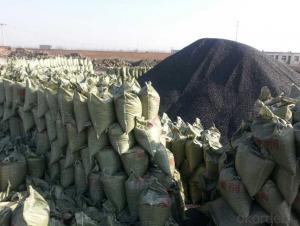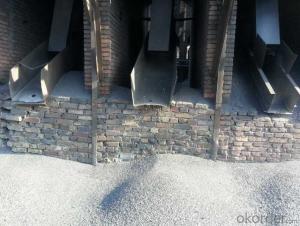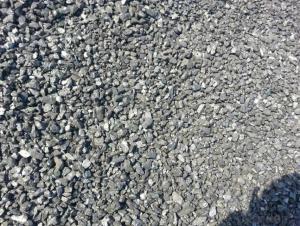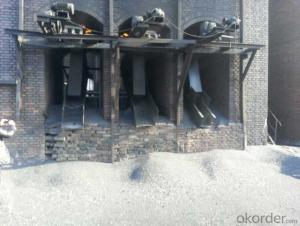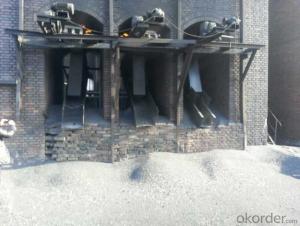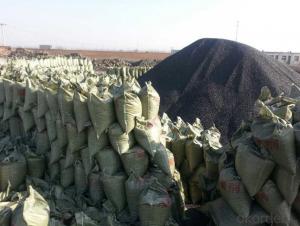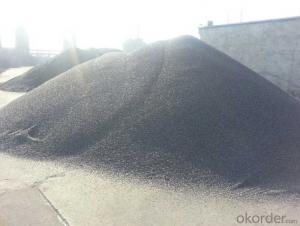Charge Coke FC82-90 Made From Taixi Anthracite
- Loading Port:
- Lianyungang
- Payment Terms:
- TT OR LC
- Min Order Qty:
- 20 m.t.
- Supply Capability:
- 3500 m.t./month
OKorder Service Pledge
OKorder Financial Service
You Might Also Like
Charge Coke FC82-90
Features
Calcined Anthracite
Fixed carbon: 90%-95%
S: 0.5% max
Size: 0-3. 3-5.3-15 or as request
It used the high quality anthracite as raw materials through high temperature calcined at over 2000 by the DC electric calciner with results in eliminating the moisture and volatile matter from anthracite efficiently, improving the density and the electric conductivity and strengthening the mechanical strength and anti-oxidation. It has good characteristics with low ash, low resistvity, low sulphur, high carbon and high density. It is the best material for high quality carbon products.
Packaging & Delivery
25kgs/50kgs/1ton per bag or as buyer's request
Advantage and competitive of caclined anthracite
1. strong supply capability
2. fast transportation
3. lower and reasonable price for your reference
4.low sulphur, low ash
5.fixed carbon:95% -90%
6..sulphur:lower than 0.3%
General Specification of Calcined Anthracite
| FC | 95 | 94 | 93 | 92 | 90 |
| ASH | 4 | 5 | 6 | 6.5 | 8.5 |
| V.M. | 1 | 1 | 1 | 1.5 | 1.5 |
| S | 0.3 | 0.3 | 0.3 | 0.35 | 0.35 |
| MOISTURE | 0.5 | 0.5 | 0.5 | 0.5 | 0.5 |
Pictures
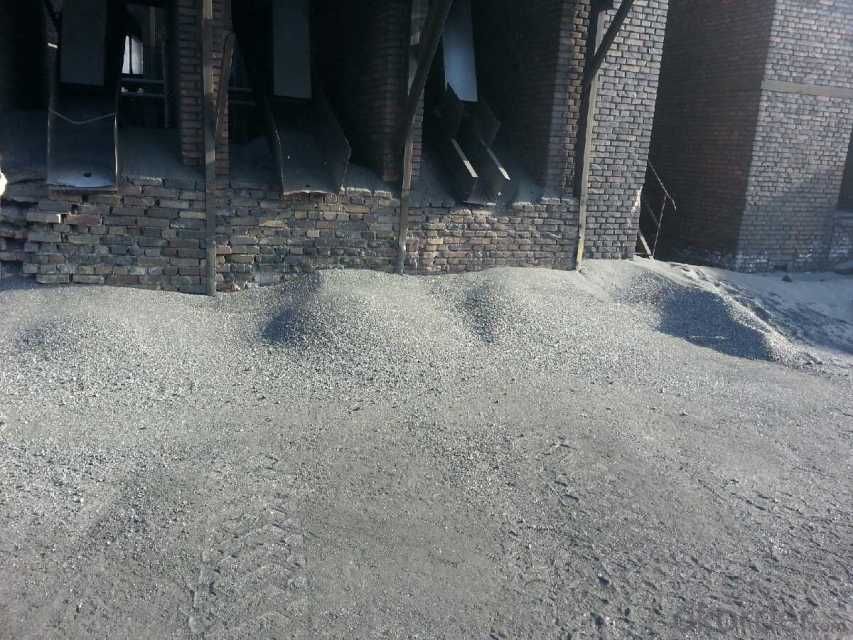
- Q: How is carbon formed?
- Various natural processes contribute to the formation of carbon, primarily the life and death cycle of living organisms. The process of photosynthesis in plants initiates carbon formation, as they utilize sunlight, water, and atmospheric carbon dioxide to produce glucose. This glucose is then transformed into other organic compounds, including carbohydrates, fats, and proteins, which are the fundamental constituents of all living beings. When plants and animals perish, decomposers like fungi and bacteria break down their remains and waste materials. During this decomposition, carbon is released back into the environment in the form of carbon dioxide or methane gas. Additionally, some organic matter may become buried beneath sediment layers, where it undergoes fossilization over millions of years. Through a combination of heat and pressure, this fossilization process converts the organic matter into fossil fuels like coal, oil, and natural gas, which are abundant sources of carbon. In addition to biological processes, carbon can also form through geological processes. Volcanic eruptions discharge carbon dioxide into the atmosphere, and over extended periods, this carbon dioxide can dissolve in water and react with minerals to create rocks like limestone. These rocks function as carbon sinks, storing substantial amounts of carbon over geological timescales. In general, the formation and cycling of carbon involve a complex interaction between biological and geological processes, significantly contributing to the equilibrium of carbon in the Earth's atmosphere and supporting life as we currently understand it.
- Q: What is carbon emission and what harm does it do? How can carbon dioxide be prevented?
- The thermodynamic partial oxidation to synthesis gas, there is a relationship between O2 and CH4 mole ratio on deposition temperature, in the actual production is done, according to raw materials the ratio of the different temperature conditions of the appropriate choice, or according to the different ratio of raw materials, select the appropriate reaction temperature, to minimize coking of the catalyst.According to the metal partial oxidation of methane to Syngas in the catalyst, at different temperatures of pure CH4 and CO in nickel catalyst coke rate, found under the temperature of 1123K, 2CO is CO2+C rate than methane dissociation rates were slow 20 times and 5 times, which indicates that the catalytic pyrolysis of methane is the main way to deposit formation.
- Q: What are the impacts of carbon emissions on coral reefs?
- Carbon emissions have significant impacts on coral reefs. One of the most significant consequences is the process of ocean acidification, caused by the absorption of excess carbon dioxide (CO2) from the atmosphere. As the ocean becomes more acidic, coral reefs struggle to build and maintain their calcium carbonate skeletons, essential for their structure and survival. This can lead to reduced growth rates and weakened reefs, making them more susceptible to damage from storms, disease, and other stressors. Additionally, the rising ocean temperatures resulting from carbon emissions have led to widespread coral bleaching events. When corals experience prolonged exposure to high temperatures, they expel the symbiotic algae (zooxanthellae) living within their tissues, which provide them with essential nutrients and give them their vibrant colors. Without these algae, corals become pale or completely white, a phenomenon known as bleaching. If the stressors subside, corals can recover, but if the bleaching is severe or prolonged, it can lead to coral death and the subsequent degradation of the reef ecosystem. Furthermore, increased carbon emissions contribute to the intensification of storms and other extreme weather events, which pose a direct threat to coral reefs. Stronger storms can physically damage the reefs, breaking apart their fragile structures and reducing their resilience. The resulting sediment runoff from land, often exacerbated by storms, can smother corals and hinder their ability to feed and grow. The impacts of carbon emissions on coral reefs are not only detrimental to these diverse marine ecosystems but also to the millions of people who depend on them for food, income, and coastal protection. Coral reefs support a vast array of marine life, provide a source of livelihood for many communities through fishing and tourism, and act as natural barriers against storm surge and coastal erosion. The degradation of coral reefs due to carbon emissions threatens the livelihoods and well-being of these communities, as well as the overall health and biodiversity of our oceans. To mitigate these impacts, it is essential to reduce carbon emissions by transitioning to cleaner, renewable energy sources, promoting sustainable practices on land to reduce runoff and pollution, and implementing effective management and conservation measures to protect and restore coral reef ecosystems.
- Q: What is carbon black dye?
- Carbon black dye is a type of dye that is derived from carbon black, which is a fine black powder made from the incomplete combustion of hydrocarbon materials. It is commonly used as a pigment and dye in various industries, including the manufacturing of ink, paint, rubber, plastics, and textiles. Carbon black dye is highly valued for its intense black color and excellent lightfastness, meaning it does not fade easily when exposed to sunlight or other sources of light. Due to its strong coloring properties, carbon black dye is also used to add depth and darkness to other colors, making them more vibrant and visually appealing. Additionally, carbon black dye is known for its good heat stability, chemical resistance, and electrical conductivity, making it suitable for a wide range of applications.
- Q: What are the consequences of increased carbon emissions on human health?
- Increased carbon emissions have significant consequences on human health. One of the most immediate impacts is the deterioration of air quality. Carbon emissions contribute to the formation of harmful air pollutants, such as particulate matter, nitrogen oxides, and ground-level ozone. These pollutants can cause respiratory problems, such as asthma, bronchitis, and other chronic obstructive pulmonary diseases. They can also exacerbate existing respiratory conditions, leading to increased hospitalizations and premature deaths. Furthermore, carbon emissions contribute to the phenomenon of climate change, which has far-reaching effects on human health. Rising temperatures can exacerbate the occurrence and intensity of heatwaves, leading to heat-related illnesses and deaths. Heat stress also affects vulnerable populations, such as the elderly, children, and those with pre-existing health conditions. Climate change also impacts the spread of infectious diseases. Warmer temperatures and changing rainfall patterns can alter the distribution and behavior of disease-carrying vectors like mosquitoes and ticks. This can result in the increased transmission of vector-borne diseases, such as malaria, dengue fever, and Lyme disease. Additionally, climate change can disrupt food and water supplies, leading to malnutrition and an increased risk of waterborne diseases. Another consequence of carbon emissions is the increased occurrence of natural disasters, such as hurricanes, floods, and wildfires. These events can cause physical injuries, displacement, and mental health issues, such as post-traumatic stress disorder. The destruction of healthcare infrastructure during disasters also hampers access to necessary medical care, exacerbating health issues. It is important to note that the consequences of increased carbon emissions on human health disproportionately affect vulnerable populations, including low-income communities, indigenous communities, and developing countries. These groups often have limited access to healthcare, making them more susceptible to the health impacts of carbon emissions. In conclusion, increased carbon emissions have severe consequences on human health. From deteriorating air quality to the spread of infectious diseases and the occurrence of natural disasters, the impacts are wide-ranging and pose significant risks to individuals and communities. It is crucial to mitigate carbon emissions and invest in sustainable practices to safeguard human health and create a healthier and more sustainable future.
- Q: Carbon content of fly ash and fly ash roasted vector what is the relationship?
- The loss of coal ash is mainly caused by the incomplete combustion of coal, the remaining carbon is introduced, and the carbon content is high, then the amount of burning is high. From the color, it can be clearly seen that the black fly ash has high carbon content and high ignition loss. Based on the molecular weights of C and CO2, a preliminary estimate is made.
- Q: How does carbon affect air quality?
- Carbon can have both positive and negative effects on air quality. On one hand, carbon dioxide (CO2) is a natural component of the Earth's atmosphere and is necessary for the survival of plants and photosynthesis. However, excessive amounts of CO2 can contribute to the greenhouse effect, leading to global warming and climate change. Additionally, carbon monoxide (CO), a byproduct of incomplete combustion, is a harmful pollutant that can negatively impact air quality. It is primarily emitted from vehicles, industrial processes, and residential heating systems. High levels of carbon monoxide can impair the delivery of oxygen to the body, leading to various health issues, including headaches, dizziness, and in extreme cases, even death. Furthermore, carbon-containing compounds such as volatile organic compounds (VOCs) can contribute to the formation of ground-level ozone, a harmful pollutant. Ground-level ozone can cause respiratory problems, aggravate existing respiratory conditions, and reduce lung function. VOCs are emitted from various sources, including vehicle emissions, industrial processes, and certain household products. In conclusion, while carbon dioxide is essential for life on Earth, excessive amounts can contribute to climate change. On the other hand, carbon monoxide and volatile organic compounds emitted from human activities can negatively impact air quality and human health. Therefore, it is crucial to reduce carbon emissions and adopt cleaner technologies to mitigate the adverse effects of carbon on air quality.
- Q: What kind of industry does high-performance carbon fiber belong to?
- High performance carbon fiber is used in many industries, such as automobiles, bicycles, and even the aviation industry.. If you look at the industry type, many industries have high-performance carbon fiber figure, if divided by the industry attributes, should belong to the emerging industry, the future potential of the industry
- Q: What should I do when carbon monoxide leaks?
- Be careful not to let their affected by the cold, otherwise, may make the body temperature decreased cardiac arrest. If the poisoned person can drink, can feed the hot tea and sugar, to keep warm, cold towel head can not be used, but can not pour cold water. Poisoning breathing difficulties or just stop breathing, artificial respiration should be immediately closed chest cardiac massage or first aid, and to call the ambulance the unit, or ask the neighbors to help, send the patient to the hospital for treatment.
- Q: What is carbon neutral tourism?
- Carbon neutral tourism refers to a form of tourism that aims to minimize or eliminate the carbon footprint generated by travel and related activities. It is an approach that seeks to balance the amount of carbon dioxide released into the atmosphere with an equivalent amount of carbon dioxide removed or offset. To achieve carbon neutrality, tourism operators and destinations take various measures to reduce their greenhouse gas emissions. This can include using renewable energy sources, implementing energy-efficient practices, promoting sustainable transport options, and adopting eco-friendly technologies. Additionally, carbon offsetting is often employed, which involves investing in projects that reduce greenhouse gas emissions elsewhere, such as reforestation or renewable energy initiatives. The concept of carbon neutral tourism recognizes the significant contribution of the travel and tourism industry to global carbon emissions. According to the United Nations World Tourism Organization, tourism accounts for around 8% of global greenhouse gas emissions. By embracing carbon neutrality, the industry acknowledges its responsibility to minimize its environmental impact and contribute to climate change mitigation efforts. One of the key benefits of carbon neutral tourism is the reduction of greenhouse gas emissions, which helps combat climate change. By adopting sustainable practices and offsetting remaining emissions, destinations and operators can play a crucial role in preserving natural resources, protecting biodiversity, and minimizing pollution. Moreover, carbon neutral tourism can also enhance the reputation and competitiveness of businesses and destinations, attracting environmentally conscious travelers who prioritize sustainability. However, it is important to note that achieving carbon neutrality is a complex task that requires commitment and collaboration from all stakeholders involved in the tourism industry. It involves measuring and monitoring emissions, setting reduction targets, implementing sustainable practices, and investing in carbon offset projects. Moreover, transparency and credibility are crucial in ensuring that carbon offset initiatives are verifiable and contribute to real emissions reductions. In conclusion, carbon neutral tourism is a proactive approach to minimize the environmental impact of travel and tourism activities. It involves reducing emissions and offsetting remaining ones to achieve a net-zero carbon footprint. By embracing carbon neutrality, the tourism industry can contribute to global climate change mitigation efforts while simultaneously promoting sustainable practices and attracting environmentally conscious travelers.
Send your message to us
Charge Coke FC82-90 Made From Taixi Anthracite
- Loading Port:
- Lianyungang
- Payment Terms:
- TT OR LC
- Min Order Qty:
- 20 m.t.
- Supply Capability:
- 3500 m.t./month
OKorder Service Pledge
OKorder Financial Service
Similar products
Hot products
Hot Searches
